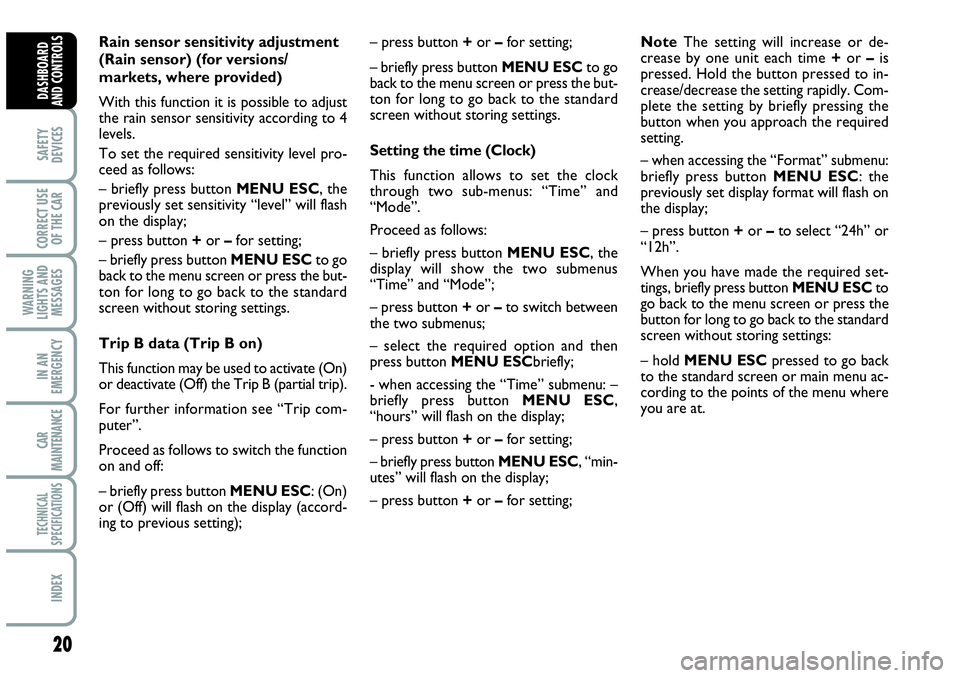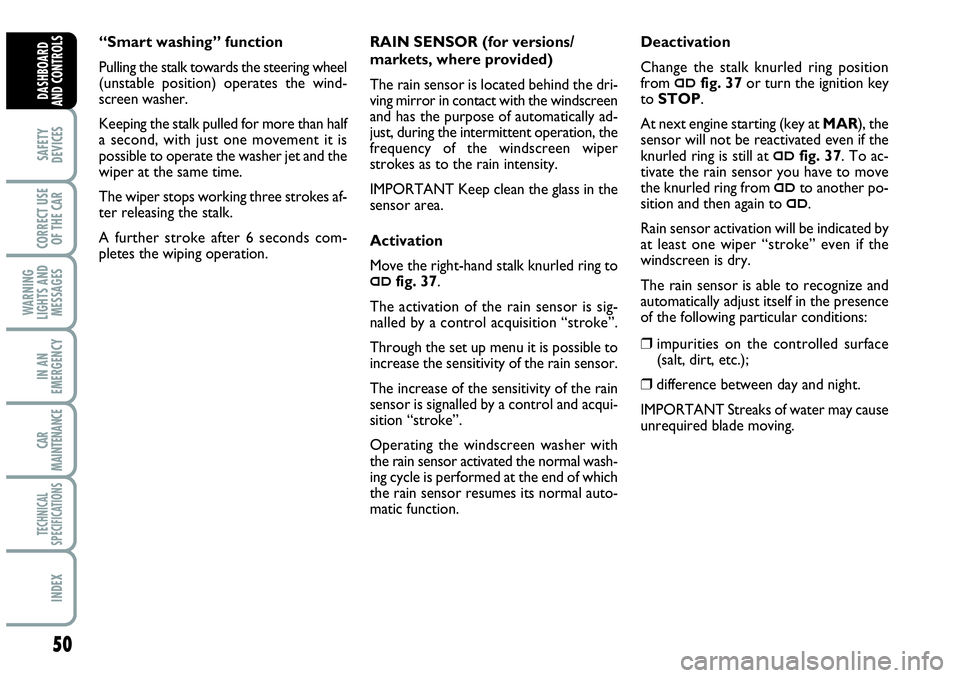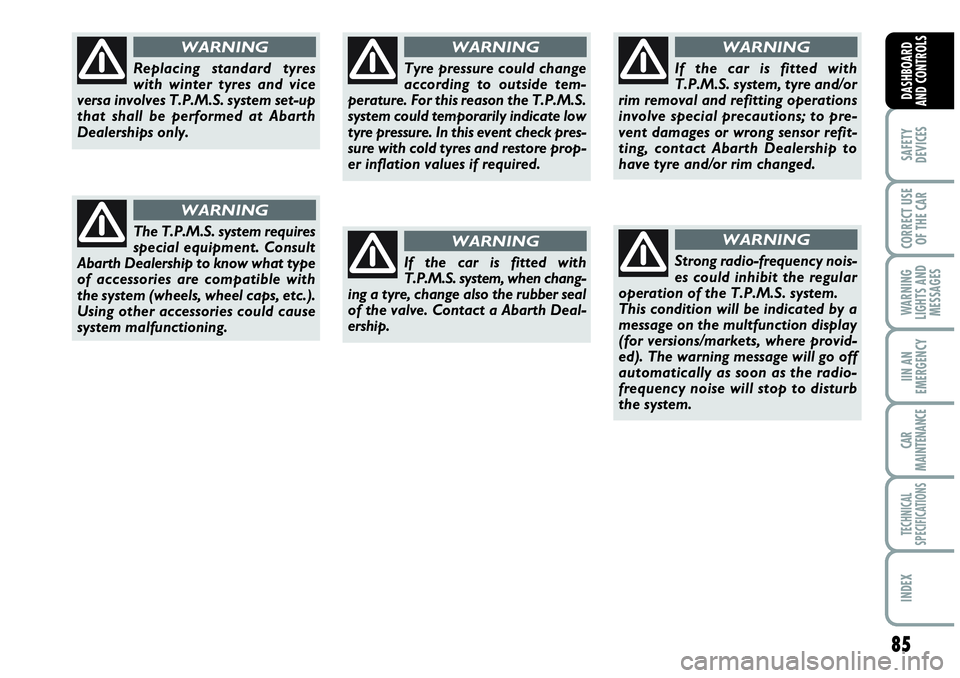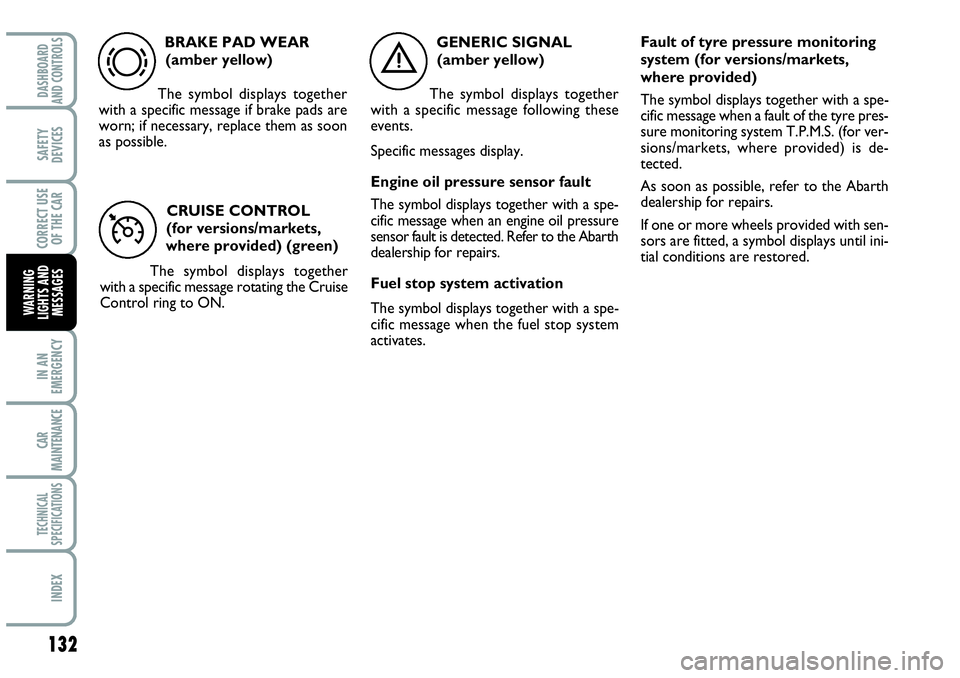sensor Abarth Grande Punto 2010 Owner handbook (in English)
[x] Cancel search | Manufacturer: ABARTH, Model Year: 2010, Model line: Grande Punto, Model: Abarth Grande Punto 2010Pages: 207, PDF Size: 3.01 MB
Page 20 of 207

18
SAFETY
DEVICES
CORRECT USE
OF THE CAR
WARNING
LIGHTS AND
MESSAGES
IN AN
EMERGENCY
CAR
MAINTENANCE
TECHNICAL
SPECIFICATIONS
INDEX
DASHBOARD
AND CONTROLS
Example:
TürkçeNederlands
Español
Português
Français
Polski
Italiano
Deutsch
BELT BUZZERSET TIME
SEE RADIO
AUTOCLOSE
UNIT LANGUAGE BUZZER VOL. BUTTON VOL.
MEMU ESC
briefly press
fig. 19
SERVICE
F0R2007g
TRIP B DATA SPEED BEEP
EXIT MENU
PASSENGER BAG
English
On the standard screen, briefly press MENU ESCto start brows-
ing. Press +or –to browse within the menu. Note Only the short
menu may be accessed for reasons of safety while the car is moving
(“Brightness” and “Speed Beep”).
MENU ESC
briefly press
YearMouth
Day
FIRST PAGERAIN SENSOR
(for versions/markets,
where provided)
SET DATA
Page 22 of 207

20
SAFETY
DEVICES
CORRECT USE
OF THE CAR
WARNING
LIGHTS AND
MESSAGES
IN AN
EMERGENCY
CAR
MAINTENANCE
TECHNICAL
SPECIFICATIONS
INDEX
DASHBOARD
AND CONTROLS
Rain sensor sensitivity adjustment
(Rain sensor) (for versions/
markets, where provided)
With this function it is possible to adjust
the rain sensor sensitivity according to 4
levels.
To set the required sensitivity level pro-
ceed as follows:
– briefly press button MENU ESC, the
previously set sensitivity “level” will flash
on the display;
– press button +or –for setting;
– briefly press button MENU ESCto go
back to the menu screen or press the but-
ton for long to go back to the standard
screen without storing settings.
Trip B data (Trip B on)
This function may be used to activate (On)
or deactivate (Off) the Trip B (partial trip).
For further information see “Trip com-
puter”.
Proceed as follows to switch the function
on and off:
– briefly press button MENU ESC: (On)
or (Off) will flash on the display (accord-
ing to previous setting);– press button +or –for setting;
– briefly press button MENU ESCto go
back to the menu screen or press the but-
ton for long to go back to the standard
screen without storing settings.
Setting the time (Clock)
This function allows to set the clock
through two sub-menus: “Time” and
“Mode”.
Proceed as follows:
– briefly press button MENU ESC, the
display will show the two submenus
“Time” and “Mode”;
– press button +or –to switch between
the two submenus;
– select the required option and then
press button MENU ESCbriefly;
- when accessing the “Time” submenu: –
briefly press button MENU ESC,
“hours” will flash on the display;
– press button +or –for setting;
– briefly press button MENU ESC, “min-
utes” will flash on the display;
– press button +or –for setting;Note The setting will increase or de-
crease by one unit each time +or –is
pressed. Hold the button pressed to in-
crease/decrease the setting rapidly. Com-
plete the setting by briefly pressing the
button when you approach the required
setting.
– when accessing the “Format” submenu:
briefly press button MENU ESC: the
previously set display format will flash on
the display;
– press button +or –to select “24h” or
“12h”.
When you have made the required set-
tings, briefly press button MENU ESCto
go back to the menu screen or press the
button for long to go back to the standard
screen without storing settings:
– hold MENU ESC
pressed to go back
to the standard screen or main menu ac-
cording to the points of the menu where
you are at.
Page 42 of 207

40
SAFETY
DEVICES
CORRECT USE
OF THE CAR
WARNING
LIGHTS AND
MESSAGES
IN AN
EMERGENCY
CAR
MAINTENANCE
TECHNICAL
SPECIFICATIONS
INDEX
DASHBOARD
AND CONTROLS
AUTOMATIC
TWO-ZONE
CLIMATE
CONTROL SYSTEM
(for versions/markets,
where provided)
DESCRIPTION
The car is fitted with a two-zone climate
control system which makes it possible to
separately adjust the air temperatures and
air distribution on the driver’s side and on
the passenger’s side. Temperature control
is based on the “equivalent temperature”
logic, i.e.: the system continuously works
to keep constant the comfort inside the
passenger compartment and to compen-
sate any variation of the outside climate
conditions, including sunshine detected by
a proper sensor provided for the purpose.
The climate control system automatically
controls and adjusts the following para-
meters and functions:
❒ air temperature at driver/front passen-
ger vents;
❒ air distribution at driver/front passen-
ger vents;
❒ fan speed (continuous air flow varia-
tion);
❒compressor activation (to cool/ dehu-
midify air);
❒air recirculation.All the above functions can be changed
manually by selecting the required func-
tion/s and by changing the set parameters.
In this way the automatic control is de-
activated; the system will resume auto-
matic control only for safety reasons. Man-
ual selections prevail over automatic ones
and remain in storage until the user de-
cides to resume automatic control (press
button AUTO), except when the system
cuts in for particular safety conditions. The
control of functions not changed manual-
ly remains automatic. The amount of air
admitted to the passenger compartment
does not depend on the car speed, since
it is electronically controlled by the fan.
The temperature of the air admitted to
the passenger compartment is always con-
trolled automatically according to the tem-
peratures set on the driver’s and front
passenger’s display (except when the sys-
tem is off or under certain conditions
when the compressor is off).The following parameters and functions
can be set or changed manually:
❒ air temperatures on driver/front pas-
senger side;
❒fan speed (continuous variation);
❒air distribution on seven levels (dri-
ver/front passenger side);
❒ climate control compressor on/off en-
able;
❒monozone/two-zone distribution prior-
ity;
❒ fast demisting/defrosting;
❒ air recirculation;
❒ rear heated window;
❒system deactivation.
Page 52 of 207

50
SAFETY
DEVICES
CORRECT USE
OF THE CAR
WARNING
LIGHTS AND
MESSAGES
IN AN
EMERGENCY
CAR
MAINTENANCE
TECHNICAL
SPECIFICATIONS
INDEX
DASHBOARD
AND CONTROLS
RAIN SENSOR (for versions/
markets, where provided)
The rain sensor is located behind the dri-
ving mirror in contact with the windscreen
and has the purpose of automatically ad-
just, during the intermittent operation, the
frequency of the windscreen wiper
strokes as to the rain intensity.
IMPORTANT Keep clean the glass in the
sensor area.
Activation
Move the right-hand stalk knurled ring to
≤fig. 37.
The activation of the rain sensor is sig-
nalled by a control acquisition “stroke”.
Through the set up menu it is possible to
increase the sensitivity of the rain sensor.
The increase of the sensitivity of the rain
sensor is signalled by a control and acqui-
sition “stroke”.
Operating the windscreen washer with
the rain sensor activated the normal wash-
ing cycle is performed at the end of which
the rain sensor resumes its normal auto-
matic function.Deactivation
Change the stalk knurled ring position
from
≤fig. 37or turn the ignition key
to STOP.
At next engine starting (key at MAR), the
sensor will not be reactivated even if the
knurled ring is still at
≤fig. 37. To ac-
tivate the rain sensor you have to move
the knurled ring from
≤to another po-
sition and then again to
≤.
Rain sensor activation will be indicated by
at least one wiper “stroke” even if the
windscreen is dry.
The rain sensor is able to recognize and
automatically adjust itself in the presence
of the following particular conditions:
❒ impurities on the controlled surface
(salt, dirt, etc.);
❒difference between day and night.
IMPORTANT Streaks of water may cause
unrequired blade moving. “Smart washing” function
Pulling the stalk towards the steering wheel
(unstable position) operates the wind-
screen washer.
Keeping the stalk pulled for more than half
a second, with just one movement it is
possible to operate the washer jet and the
wiper at the same time.
The wiper stops working three strokes af-
ter releasing the stalk.
A further stroke after 6 seconds com-
pletes the wiping operation.
Page 87 of 207

85
SAFETY
DEVICES
CORRECT USE
OF THE CAR
WARNING
LIGHTS AND
MESSAGES
IIN AN
EMERGENCY
CAR
MAINTENANCE
TECHNICAL
SPECIFICATIONS
INDEX
DASHBOARD
AND CONTROLS
Replacing standard tyres
with winter tyres and vice
versa involves T.P.M.S. system set-up
that shall be performed at Abarth
Dealerships only.
WARNING
The T.P.M.S. system requires
special equipment. Consult
Abarth Dealership to know what type
of accessories are compatible with
the system (wheels, wheel caps, etc.).
Using other accessories could cause
system malfunctioning.
WARNING
Tyre pressure could change
according to outside tem-
perature. For this reason the T.P.M.S.
system could temporarily indicate low
tyre pressure. In this event check pres-
sure with cold tyres and restore prop-
er inflation values if required.
WARNING
If the car is fitted with
T.P.M.S. system, tyre and/or
rim removal and refitting operations
involve special precautions; to pre-
vent damages or wrong sensor refit-
ting, contact Abarth Dealership to
have tyre and/or rim changed.
WARNING
If the car is fitted with
T.P.M.S. system, when chang-
ing a tyre, change also the rubber seal
of the valve. Contact a Abarth Deal-
ership.
WARNING
Strong radio-frequency nois-
es could inhibit the regular
operation of the T.P.M.S. system.
This condition will be indicated by a
message on the multfunction display
(for versions/markets, where provid-
ed). The warning message will go off
automatically as soon as the radio-
frequency noise will stop to disturb
the system.
WARNING
Page 88 of 207

86
SAFETY
DEVICES
CORRECT USE
OF THE CAR
WARNING
LIGHTS AND
MESSAGES
IN AN
EMERGENCY
CAR
MAINTENANCE
TECHNICAL
SPECIFICATIONS
INDEX
DASHBOARD
AND CONTROLS
–
NO
NO
YES
YES
YESYES
YES
YES
NO
NO
NO In order to use the system properly, refer to the following table when you have to change wheels/tyres:
Operation Sensor presence Failure indication Abarth Dealership
service operation
–
Wheel change with spare wheel
Wheel change
with snow tyres
Wheel change
with snow tyres
Wheel change
with others of different
size (*)
Wheel cross switching
(front/rear) (**)
(*) Given as an alternative on the Owner Handbook and available at Lineaccessori Abarth.
(**) Not cross switched (tyres shall stay on the same side).Contact Abarth
Dealership
Repair damaged
wheel
Contact Abarth
Dealership
–
–
Page 92 of 207

90
SAFETY
DEVICES
CORRECT USE
OF THE CAR
WARNING
LIGHTS AND
MESSAGES
IN AN
EMERGENCY
CAR
MAINTENANCE
TECHNICAL
SPECIFICATIONS
INDEX
DASHBOARD
AND CONTROLS
PROTECTING THE
ENVIRONMENT
The devices for curtailing emissions are
the following:
❒ three-way catalytic converter;
❒Lambda sensor;
❒fuel evaporation system.
In addition, do not let the engine run, even
for a test, with one or more spark plugs
disconnected.
Do not put naked flames or
lighted cigarettes near the
fuel filler hole as there is a danger of
fire. Do not bend too close to the hole
either so as not to breathe in harmful
vapours.
WARNING
Refuelling
To guarantee full tank filling, carry out two
refuelling operations after the first click of
the fuel delivery gun. Avoid further top-
ping up operations that could cause dam-
ages to the fuel system.
During normal service the
catalyst reaches high tem-
peratures. Do not therefore park the
car over inflammable materials (grass,
dry leaves, pine needles, etc.): fire
hazard.
WARNING
Page 134 of 207

132
IN AN
EMERGENCY
CAR
MAINTENANCE
TECHNICAL
SPECIFICATIONS
INDEX
DASHBOARD
AND CONTROLS
SAFETY
DEVICES
CORRECT USE
OF THE CAR
WARNING
LIGHTS AND
MESSAGES
BRAKE PAD WEAR
(amber yellow)
The symbol displays together
with a specific message if brake pads are
worn; if necessary, replace them as soon
as possible.
d
CRUISE CONTROL
(for versions/markets,
where provided) (green)
The symbol displays together
with a specific message rotating the Cruise
Control ring to ON.
Ü
GENERIC SIGNAL
(amber yellow)
The symbol displays together
with a specific message following these
events.
Specific messages display.
Engine oil pressure sensor fault
The symbol displays together with a spe-
cific message when an engine oil pressure
sensor fault is detected. Refer to the Abarth
dealership for repairs.
Fuel stop system activation
The symbol displays together with a spe-
cific message when the fuel stop system
activates.
è
Fault of tyre pressure monitoring
system (for versions/markets,
where provided)
The symbol displays together with a spe-
cific message when a fault of the tyre pres-
sure monitoring system T.P.M.S. (for ver-
sions/markets, where provided) is de-
tected.
As soon as possible, refer to the Abarth
dealership for repairs.
If one or more wheels provided with sen-
sors are fitted, a symbol displays until ini-
tial conditions are restored.
Page 155 of 207

153
WARNING
LIGHTS AND
MESSAGES
CAR
MAINTENANCE
TECHNICAL
SPECIFICATIONS
INDEX
DASHBOARD
AND CONTROLS
SAFETY
DEVICES
CORRECT USE
OF THE CAR
IN AN
EMERGENCY
5
7.5
5
5 12
9
3
10
USERSFUSE AMPERE
INT power supply for control panel lighting, parking control unit, tyre pressure
monitoring control unit, electric door mirrors movement, rain sensor, electric roof
control unit, by-port infotelematic socket
Air Bag control unit
Instrument panel
INT power supply for switch on brake pedal (NC contact), switch on clutch pedal,
interior heater unit, convergence control unit, car radio preparation system
Page 157 of 207

155
WARNING
LIGHTS AND
MESSAGES
CAR
MAINTENANCE
TECHNICAL
SPECIFICATIONS
INDEX
DASHBOARD
AND CONTROLS
SAFETY
DEVICES
CORRECT USE
OF THE CAR
IN AN
EMERGENCY
USERSFUSE AMPERE
ESP electric steering system control unit (+ignition power supply), NFR braking
system control unit (+ignition power supply), yaw sensor on tunnel
Left fog light, right fog light
Spare
Current socket (preparation)
Passenger compartment, cigar lighter current socket
Reversing light, relay coils on engine fuse junction unit
Defroster on driver’s door mirror, defroster on passenger side door mirror24
30
84
85
86
87
885
15
–
–
15
5
7.5